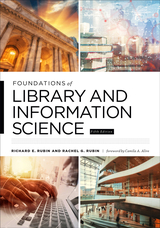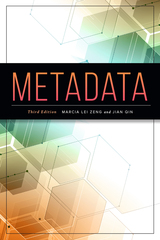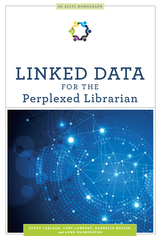
This title is no longer available from this publisher at this time. To let the publisher know you are interested in the title, please email bv-help@uchicago.edu.
This title is no longer available from this publisher at this time. To let the publisher know you are interested in the title, please email bv-help@uchicago.edu.
Metadata
by Marcia Lei Zeng and Jian Qin
American Library Association, 2008
Paper: 978-1-55570-635-7
Library of Congress Classification Z666.7.Z46 2008
Dewey Decimal Classification 025.3
Paper: 978-1-55570-635-7
Library of Congress Classification Z666.7.Z46 2008
Dewey Decimal Classification 025.3
TOC
TABLE OF CONTENTS
Contents List of Illustrations Preface Part I. Fundamentals of Metadata Chapter 1. Introduction 1.1 A Brief History 1.2 Definitions 1.3 Types and Functions 1.4 Principles 1.5 Anatomy of a Metadata Standard Suggested Readings Chapter 2. Current Standards 2.1 Metadata for General Purposes 2.1.1 Dublin Core (DC) 2.1.2 MODS and the MARC Family 2.2 Metadata for Cultural Objects and Visual Resources 2.2.1 Introduction to CDWA 2.2.2 Important Concepts 2.2.3 The Element Sets of CCO, CDWA Lite, and VRA 2.3 Metadata for Educational Resources 2.3.1 Metadata Needs for Educational Resources 2.3.2 IEEE-LOM 2.3.3 CanCore 2.3.4 Gateway to Educational Materials (GEM) 2.0 2.3.5 Dublin Core Education Application Profile (DC-ED) 2.3.6 SCORM 2.4 Archival and Preservation Metadata 2.4.1 The Encoded Archival Description (EAD) 2.4.2 Metadata for Digital Preservation 2.5 Rights Management Metadata 2.5.1 Rights Metadata Elements for User-oriented Rights Information 2.5.2 Rights-holder Communities? Metadata Activities 2.5.3 Open Digital Rights Language (ODRL) 2.6 Scientific Metadata 2.7 Metadata for Multimedia Objects 2.7.1 The MPEG Standards 2.7.2 MPEG-7 2.7.3 ID3v2 2.7.4 PBCore, the Public Broadcasting Metadata Dictionary 2.7.5 Ongoing Research and Development 2.8 Metadata Describing Agents Suggested Readings Exercises Part II. Metadata Building Blocks Chapter 3. Schemas--Structure and Semantics 3.1 Elements 3.1.1 Knowing the Difference 3.1.2 Communicating About the Functional Requirements 3.1.3 Identifying Desired Elements 3.2 Element Set 3.2.1 Basic Components 3.2.2 Principles for an Element Set to Follow 3.2.3 Methods of Working from an Existing Element Set 3.2.4 Testing the Element Set 3.3 Value Space 3.3.1 Value Spaces That Should Follow Standardized Syntax Encoding Rules 3.3.2 Value Spaces That Require Standardized Vocabulary Encoding Schemes 3.3.3 Value Spaces That Should Have Predefined Lists of Terms 3.4 Application Profiles 3.4.1 APs Consisting of Elements Drawn from Other Schemas 3.4.2 APs Based on One Schema but Tailored for Particular Application Communities 3.4.3 APs Declaring Own Namespaces 3.5 Crosswalks 3.6 Best Practice Guides and Content Standards 3.6.1 Best Practice Guides 3.6.2 Standard-specific Guidelines 3.6.3 Community-oriented Best Practice Guides 3.6.4 Data Content Standards Suggested Readings Exercises Developing a Metadata Element Set (a Multipart Project) Chapter 4. Schemas--Syntax 4.1 Schema Encoding 4.2 Namespaces 4.3 XML Schemas for Metadata Standards 4.3.1 Dublin Core Encoding Schemas 4.3.2 EAD XML Schema 4.3.3 DLESE Metadata Framework XML Schemas Suggested Readings Exercises Option1: Create an XML Schema and Apply to Record Creation Option 2: Create an XML Schema for the Option 1 Exercise Chapter 5. Metadata Records 5.1 Basic Requirements 5.2 Conceptual Models 5.2.1 Metadata Statement, Description, and Description Set 5.2.2 Relationships Between Resources 5.2.3 Content-oriented Model for the Bibliographic Universe 5.3 Levels of Granularity 5.3.1 Item and Collection Records 5.3.2 Resource Decomposition 5.4 Metadata Sources 5.4.1 Manual Generation of Metadata 5.4.2 Automatic Generation of Metadata 5.4.3 Combination Manual and Automatic Methods 5.4.4 Harvested Metadata Records 5.4.5 Converted Metadata Records 5.5 Encoding Metadata 5.5.1 Metadata Storage 5.5.2 Expressing Metadata in HTML/XHTML 5.5.3 Expressing Metadata in XML 5.5.4 Expressing Metadata in XML/RDF 5.6 Linkage, Wrapper, Display, and Parallel Metadata 5.6.1 Linking Between Descriptions for Different Resources 5.6.2 Wrapping 5.6.3 Encoding for Display 5.6.4 Encoding for Bilingual Metadata Statements 5.7 Combing Metadata Descriptions 5.7.1 METS 5.7.2 RDF 5.7.3 Aggregation 5.7.4 Conclusion Suggested Readings Exercises Part III. Metadata Services Chapter 6. Metadata Services 6.1 What Are Metadata Services? 6.2 Infrastructure for Metadata Services 6.3 Metadata Registries 6.3.1 Purposes 6.3.2 Functional Requirements 6.3.3 Types 6.3.4 Essential Components 6.4. Metadata Repositories 6.4.1 Characteristics of Metadata Repositories 6.4.2 Introduction to the Harvesting Model 6.4.3 OAI-PMH Commands 6.4.4 Support for Multiple-Record Formats in OAI-PMH 6.5 Ensuring Optimal Metadata Discovery 6.5.1 Metadata Retrieval 6.5.2 Metadata Exposure Methods 6.5.3 Other Approaches 6.6 Summary Suggested Readings Exercises Chapter 7. Metadata Quality Measurement and Improvement 7.1 Quality of Metadata 7.2 Functional Requirements of Metadata Systems 7.3 Quality Measurement with Different Granularities 7.4 Measurement Indicators 7.4.1 Completeness 7.4.2 Correctness 7.4.3 Consistency 7.4.4 Duplication Analysis 7.5 Metadata Evaluation Methodology 7.6 Enhancing Quality of Metadata Suggested Readings Exercises Chapter 8. Achieving Interoperability 8.1 Definitions 8.2 Metadata Decisions at Different Stages of a Digital Library Project 8.3 Achieving Interoperability at the Schema Level 8.3.1 Derivation 8.3.2 Application Profiles (APs) 8.3.3 Crosswalks 8.3.4 Frameworks 8.3.5 Metadata Registries 8.4 Achieving Interoperability at the Record Level 8.4.1 Conversion of Metadata Records 8.4.2 Data Reuse and Integration 8.5 Achieving Interoperability at the Repository Level 8.5.1 Metadata Repository Based on the Open Archives Initiative (OAI) Protocol 8.5.2 Metadata Repository Supporting Multiple Formats Without Record Conversion 8.5.3 Aggregation and Enriched Metadata Records in a Repository 8.5.4 Element-based and Value-based Crosswalking Services 8.5.5 Value-based Mapping for Cross-database Searching 8.5.6 Value-based Co-occurrence Mapping 8.6 Conclusion Suggested Readings Exercises Part IV. Metadata Outlook in Research Chapter 9. Metadata Research Landscape 9.1 Research in Metadata Architecture 9.2 Research in Metadata Modeling 9.3 Research in Metadata Semantics 9.4 Conclusions Suggested Readings Exercise Appendices: Sources and References Appendix A. Metadata Standards Appendix B. Value Encoding Schemes and Content Standards Standardized Vocabularies Subject Headings Lists and Thesauri Classification Schemes General Special Name Authority Lists Content Standards and Best Practice Guides Glossary Bibliography and Sources of Further Information Index About the Authors
See other books on: Language Arts & Disciplines | Library & Information Science | Metadata | Qin, Jian | Zeng, Marcia Lei
See other titles from American Library Association
Nearby on shelf for Libraries / Library science. Information science:
9780838907245
9781555705916






